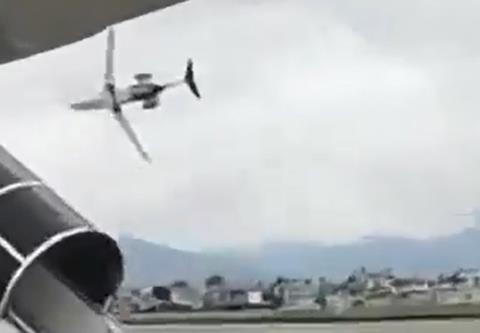Investigators probing the fatal Bombardier CRJ200 crash at Kathmandu will inevitably focus on the extraordinary attitude the aircraft developed as it lifted off from runway 02.
Nepal’s civil aviation regulator states that the captain survived the 24 July accident but the first officer, and the 17 other occupants, did not.
Video capturing the departure indicates that the Saurya Airlines aircraft lifted off and rolled steeply to the right, reaching an excessive bank of around 90° just 100-150ft above ground.
The aircraft then appears to begin recovering towards wings-level but descends, causing its right wing to strike the ground and the jet to disintegrate.
There are no immediate findings regarding the reason for the bank, and whether it was the result of a wing stall, wrongly-configured flight controls, engine failure, or other circumstances. The instrument departure pattern for the flight to Pokhara has not been confirmed.
Meteorological data from Kathmandu around the time of the crash indicates calm winds and no adverse conditions.

CRJ200s have an early supercritical wing design, derived from the Challenger business jet, with reduced curvature on the upper surface. This delays the onset of shockwaves and reduces high-speed drag.
But the design is susceptible to leading-edge stall, abrupt loss of lift and sudden drop of the wing if airflow is disturbed by wing contamination – to which it is particularly sensitive – or aggressive rotation on take-off.
Video footage of the aircraft involved in the accident, which was lightly loaded, is insufficiently clear to determine the flap configuration. CRJ200s are not equipped with leading-edge slats to improve lift, and Kathmandu is a high-elevation airport, situated above 4,000ft.
Sudden in-flight upset in the roll axis immediately after take-off could also be a consequence of incorrect configuration of flight controls, such as might occur with a reversal of aileron functions. This would normally be detected either by testing, before any scheduled passenger service, as well as a standard ‘full and free’ control-surface check by the crew.
Investigators are likely to explore the recent maintenance record for the aircraft, which was originally delivered to US operator Atlantic Coast Airlines in 2003, to determine whether any relevant flight-control work was carried out.
Nepal’s civil aviation safety oversight has been a subject of concern for several years, with all the country’s operators, including Saurya Airlines, having been blacklisted by the European Commission for more than a decade.
While the Commission has acknowledged the civil aviation authority’s commitment to improve the safety situation, an assessment late last year – just months after a high-profile fatal ATR accident in January 2023 – failed to satisfy inspectors.


























